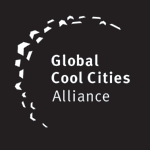This summer was a scorcher. Heat waves repeatedly struck the Midwest and South, sparing only sections of the Northeast. All of California is still in a drought. Cities were especially hot due to their concentration of buildings and human activity, a phenomenon called the urban heat island effect. At times, it may have felt impossible to beat the heat. Luckily, a recent report from ACEEE and the Global Cool Cities Alliance, Cool Policies for Cool Cities, shows how local governments enable communities to beat the heat before it starts. By employing the following cooling and energy-efficient practices before next summer, cities across North America can keep their cool:
Plant a Tree. A Chinese proverb says, “The best time to plant a tree was 20 years ago. The second best time is now.” Older trees with broad leaves and reaching branches provide a lot of shade for parks, pavements, homes, and offices, helping to keep them cool. They also clean the air and produce oxygen. Local governments often plant trees on city land, but did you know that many cities also provide free or discounted trees for planting on private land?
The Million Trees NYC program provides free trees to property owners, and runs a hotline for residents to call requesting a street tree be planted on their block.
Portland, Oregon offers a “Treebate” in the form of a $15-50 water bill credit to property owners who plant a tree on their land.
Grow Boston Greener offers a $2,500 grant competition to fund tree planting in selected neighborhoods.
Paint your roof. Dark-colored roofs trap and store heat. This heat radiates into the building, and doesn’t dissipate at night. Trapped heat is unpleasant and costly for residents who are forced to crank their AC, and is dangerous,sometimes deadly, for residents who don’t have access to air conditioning. A light-colored or reflective roof traps and stores considerably less heat. Cool roofs, for the same price as dark roofs, reflect the sun’s rays back out into the atmosphere. Recognizing the energy-efficient and publicly beneficial nature of cool roofs, some cities (and the entire State of California) require or encourage new and updated roofs to be reflective.
New and updated roofs in Los Angeles are required to meet a standard reflectiveness. To reduce the cost even further, LA’s Department of Water and Power offers a rebate of $0.20 to $0.30 per square foot.
St. Louis provides an innovative, low-cost financing option called Set the PACE St. Louis for residents replacing their traditional roof with one meeting a reflectiveness standard.
Replace dark pavement. Dark pavements also absorb, trap, and slowly release heat. You’ve experienced this running barefoot across a blacktop basketball court or parking lot. Light pavement, on the other hand, can be 50°-70°F cooler. Replacing dark pavement with vegetation also reduces the urban heat island effect. Grass and other permeable surfaces keep a city’s temperature down compared to pavement. As a bonus, they also filter stormwater. Cities have begun to encourage residents to paint parking lots, play areas, and alleyways with reflective coatings, or replace them with porous materials.
Chicago’s Green Alleys program transforms traditional alleyways into permeable ones. The program also empowers residents to derive more benefit from their green alleyways through pamphlets about landscaping and maintenance techniques.
Washington D.C.’s Riversmart programs enable individuals and communities to replace dark pavement and build green stormwater infrastructure through a series of grants and rebates.
Philadelphia offers stormwater bill credits to commercial property owners that install green stormwater infrastructure.
Vegetate your roof. A green roof eliminates the negative heat effects of a dark roof, and adds the benefits of oxygen exchange, amenity space, and opportunity for urban agriculture. Building a vegetated roof may seem like an expensive project, but many local governments are willing to share your costs.
Toronto, Ontario offers the Eco-Roof Incentive, a $75 per square meter rebate to help residents and businesses complete a green roof project.
Austin encourages green roofs by offering a variety of credits to developers for open space, parkland, and stormwater management. Density bonuses are also available.
Residents of Cincinnati may apply for a below-market-rate loan to install a vegetated roof. This is an effort through the Ohio EPA, the Metropolitan Sewer District of Greater Cincinnati, and the Cincinnati Office of Environmental & Sustainability.
Many local governments already do their part to reduce the urban heat island effect on their own properties, and some provide resources to help members of their communities do their part as well. Although the cities mentioned in this post (and many, many others!) are taking steps to reduce the urban heat island effect, every community can do more. An important driver of increasing urban heat island mitigation policies within a community is citizen demand. Strong private demand can help any of these cool technologies become standard market practice. Investing in cool technologies and buildings makes a community pleasant for all its inhabitants and visitors! Interested in learning more or cooling down your own city? First, check out the report to see what your city is doing to create a cool community. Next, participate in the programs that are available. If you aren’t impressed with what is offered, get involved and ask your city to keep its cool.
Originally posted on ACEEE’s blog: http://aceee.org/blog/2014/08/4-ways-your-city-can-be-cooler-next-s
